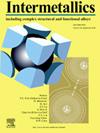Vacuum brazing of Ti2AlNb alloy with AgCu/Ti/AgCu sandwich filler metal.
IF 4.3
2区 材料科学
Q2 CHEMISTRY, PHYSICAL
引用次数: 0
Abstract
An AgCu/Ti/AgCu sandwich filler metal was designed to achieve sound joining of Ti2AlNb alloy at low brazing temperature. The effects of brazing parameters on the microstructure, mechanical properties, and fracture behavior of the resultant joints were investigated. The typical microstructure of the joint was Ti2AlNb/AlCu2Ti + Nb(s, s)/Ag(s, s) + Cu(s, s) + Cu4Ti3/AlCu2Ti + Nb(s, s)/Ti2AlNb. With the increment of the brazing temperature and the holding time, the fracture paths were shifted from Zone Ⅰ to Zone Ⅱ and then to Zone Ⅰ. The shear strength of the joints indicated a trend of increasing and then sharply decreasing. The shear strength reached 292.67 MPa at 900 °C for 10 min, and the fracture morphology exhibited the mixed tough-brittle feature.
求助全文
约1分钟内获得全文
求助全文
来源期刊

Intermetallics
工程技术-材料科学:综合
CiteScore
7.80
自引率
9.10%
发文量
291
审稿时长
37 days
期刊介绍:
This journal is a platform for publishing innovative research and overviews for advancing our understanding of the structure, property, and functionality of complex metallic alloys, including intermetallics, metallic glasses, and high entropy alloys.
The journal reports the science and engineering of metallic materials in the following aspects:
Theories and experiments which address the relationship between property and structure in all length scales.
Physical modeling and numerical simulations which provide a comprehensive understanding of experimental observations.
Stimulated methodologies to characterize the structure and chemistry of materials that correlate the properties.
Technological applications resulting from the understanding of property-structure relationship in materials.
Novel and cutting-edge results warranting rapid communication.
The journal also publishes special issues on selected topics and overviews by invitation only.
 求助内容:
求助内容: 应助结果提醒方式:
应助结果提醒方式:


